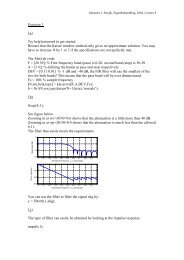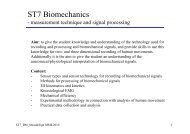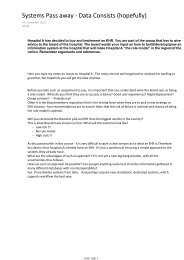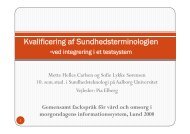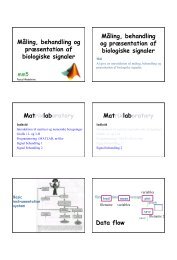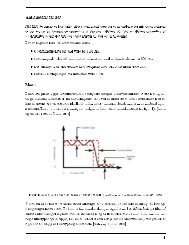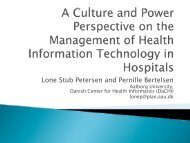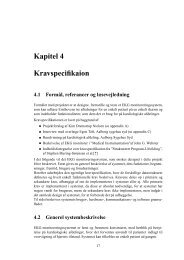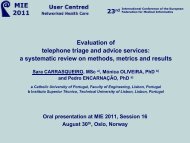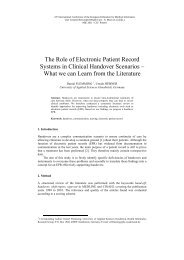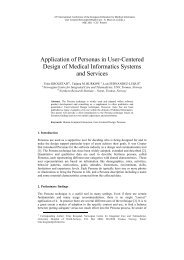Reversible Anonymization of DICOM Images Using Automatically ...
Reversible Anonymization of DICOM Images Using Automatically ...
Reversible Anonymization of DICOM Images Using Automatically ...
Create successful ePaper yourself
Turn your PDF publications into a flip-book with our unique Google optimized e-Paper software.
Medical Informatics in a United and Healthy Europe<br />
K.-P. Adlassnig et al. (Eds.)<br />
IOS Press, 2009<br />
© 2009 European Federation for Medical Informatics. All rights reserved.<br />
doi:10.3233/978-1-60750-044-5-861<br />
<strong>Reversible</strong> <strong>Anonymization</strong> <strong>of</strong><br />
<strong>DICOM</strong> <strong>Images</strong> <strong>Using</strong><br />
<strong>Automatically</strong> Generated Policies<br />
Michael ONKEN a,1 , Jörg RIESMEIER b , Marcel ENGEL c , Adem YABANCI c ,<br />
Bernhard ZABEL d , Stefan DESPRÉS c,d<br />
a OFFIS – Institute for Information Technology, Oldenburg, Germany<br />
b ICSMED AG, Oldenburg, Germany<br />
c M-SPEC GmbH, Mainz, Germany<br />
d Center for Paediatrics Medicine, Freiburg University Hospital, Germany<br />
1. Introduction<br />
Abstract. Many real-world applications in the area <strong>of</strong> medical imaging like case<br />
study databases require separation <strong>of</strong> identifying (IDATA) and non-identifying<br />
(MDATA) data, specifically those <strong>of</strong>fering Internet-based data access. These kinds<br />
<strong>of</strong> projects also must provide a role-based access system, controlling, how patient<br />
data must be organized and how it can be accessed. On <strong>DICOM</strong> image level,<br />
different image types support different kind <strong>of</strong> information, intermixing IDATA<br />
and MDATA in a single object. To separate them, it is possible to reversibly<br />
anonymize <strong>DICOM</strong> objects by substituting IDATA by a unique anonymous token.<br />
In case that later an authenticated user needs full access to an image, this token can<br />
be used for re-linking formerly separated IDATA and MDATA, thus resulting in a<br />
dynamically generated, exact copy <strong>of</strong> the original image. The approach described<br />
in this paper is based on the automatic generation <strong>of</strong> anonymization policies from<br />
the <strong>DICOM</strong> standard text, providing specific support for all kinds <strong>of</strong> <strong>DICOM</strong><br />
images. The policies are executed by a newly developed framework based on the<br />
<strong>DICOM</strong> toolkit DCMTK and <strong>of</strong>fer a reliable approach to reversible anonymization.<br />
The implementation is evaluated in a German BMBF-supported expert network in<br />
the area <strong>of</strong> skeletal dysplasias, SKELNET, but may generally be applicable to<br />
related projects, enormously improving quality and integrity <strong>of</strong> diagnostics in a<br />
field focused on images. It performs effectively and efficiently on real-world test<br />
images from the project and other kind <strong>of</strong> <strong>DICOM</strong> images.<br />
Keywords. <strong>DICOM</strong>, reversible anonymization, SKELNET, rare diseases<br />
The SKELNET [1] project is an emerging German expert network that is designed to<br />
collect cases <strong>of</strong> skeletal dysplasia which are rare diseases including more than 350<br />
different forms <strong>of</strong> genetically caused affections <strong>of</strong> bone development. Typically,<br />
medical imaging supports diagnosis, follow-up and clinical evaluation. Accordingly,<br />
the project provides – besides other services for data collection – a <strong>DICOM</strong> image<br />
archive (PACS). <strong>Images</strong> being stored to that PACS can be evaluated easily by the few<br />
specialists in the field; thus, the consultation process can be significantly shortened and<br />
1 Corresponding Author: Michael Onken, OFFIS – Institute for Information Technology, Escherweg 2,<br />
26121 Oldenburg, Germany; E-mail: onken@<strong>of</strong>fis.de.<br />
861
862<br />
formalized. Generally, <strong>DICOM</strong> images being sent to the SKELNET archive must pass<br />
through the Internet until they reach the SKELNET architecture. This requires<br />
encryption and early elimination <strong>of</strong> all identifying data (IDATA) resulting in an<br />
anonymous <strong>DICOM</strong> image still containing all relevant medical information (MDATA).<br />
Extracted IDATA and the remaining anonymized <strong>DICOM</strong> object are then marked by a<br />
“token” that allows for later re-assembling <strong>of</strong> the original object. After this process,<br />
herein called “reversible anonymization”, the two <strong>DICOM</strong> data blocks are stored<br />
within two physically separated databases according to the data privacy rules in<br />
Germany. Clinically, authenticated SKELNET physicians potentially stating diagnoses<br />
will see patient-related data (including images) within a de-anonymized state. All<br />
decisions will, therefore, base on the re-assembled, original <strong>DICOM</strong> objects; all others<br />
can access anonymized <strong>DICOM</strong> images. In the described context, this paper presents<br />
an approach for the reversible anonymization on the <strong>DICOM</strong> object level.<br />
2. Problem<br />
<strong>DICOM</strong> images require special handling for physically separating IDATA and<br />
MDATA, because all this information is usually mixed-up in a single <strong>DICOM</strong> object.<br />
Thus, all IDATA must be extracted from the object with only MDATA remaining.<br />
Furthermore, for enabling full access to the original images as required in SKELNET,<br />
it must be possible to fully reverse the anonymization process by re-creating a<br />
semantically equivalent copy <strong>of</strong> the original image.<br />
There are more than 70 different kinds <strong>of</strong> <strong>DICOM</strong> objects defined that can be<br />
stored to a PACS, ranging from images (e.g., CT, MR) to non-image information (like<br />
ECG). <strong>DICOM</strong> exactly specifies which information is required to be stored for a<br />
specific object type. This information is defined as a tree <strong>of</strong> so-called attributes, with<br />
each attribute (e.g., defining “Patient’s Name” or “Modality” information) being <strong>of</strong> a<br />
prescribed <strong>DICOM</strong> data type and permitting a specific range <strong>of</strong> values. There are<br />
attributes that are mandatory for a particular image type, but only optional, conditional<br />
or even not permitted at all in others. As a consequence, <strong>DICOM</strong> objects (even <strong>of</strong> the<br />
same type) can differ substantially in the amount and type <strong>of</strong> information stored. Also,<br />
for a single <strong>DICOM</strong> object, different kinds <strong>of</strong> encodings are permitted and must be<br />
considered 2 . Furthermore, it is not feasible to just delete all known <strong>DICOM</strong> attributes<br />
that may contain IDATA because such an approach could result in invalid <strong>DICOM</strong><br />
objects violating <strong>DICOM</strong>’s attribute constraints described above.<br />
Reversing anonymization <strong>of</strong> the archive’s <strong>DICOM</strong> objects mainly requires the<br />
correct re-insertion <strong>of</strong> IDATA formerly extracted. Due to the possibilities <strong>of</strong>fered by<br />
the <strong>DICOM</strong> Query/Retrieve protocol, it must also be considered that the encoding <strong>of</strong><br />
the object may have changed intermittently.<br />
3. Materials and Methods<br />
M. Onken et al. / <strong>Reversible</strong> <strong>Anonymization</strong> <strong>of</strong> <strong>DICOM</strong> <strong>Images</strong><br />
The <strong>DICOM</strong> Standard [2] comprehensively describes on over 1,000 pages which<br />
attributes are mandatory and optional for each object type and the attribute values being<br />
2 A single <strong>DICOM</strong> object may be encoded varying in compression, storage <strong>of</strong> multi-byte value<br />
(endianness), data type encoding, etc. without changing semantically.
permitted. There are two general anonymization approaches: Either a negative list<br />
being common for all image types could be used, specifying which <strong>of</strong> the 2,500<br />
existing <strong>DICOM</strong> attributes may contain IDATA information and therefore must be<br />
cleaned or deleted (respecting the constraints <strong>of</strong> the corresponding <strong>DICOM</strong> object type),<br />
or a positive list could be considered, listing for each object type which attributes may<br />
be safely taken over (the MDATA) into the anonymized object and which data (the<br />
IDATA) has to be removed or cleaned.<br />
For the current project, a positive list 3 was chosen. This decision was mainly<br />
taken, because then the resulting, anonymized objects <strong>of</strong> a specific object type (e.g., all<br />
CT images) will contain a defined set <strong>of</strong> attributes which can be fully controlled by the<br />
anonymization rules and therefore, by the SKELNET project operators. This is an<br />
important advantage providing a consistently defined set <strong>of</strong> attributes (“feature set”) for<br />
each image type in the archive to the SKELNET users. Furthermore, basic objects with<br />
a minimum set <strong>of</strong> attributes can be constructed during anonymization, enriched by a<br />
well-defined set <strong>of</strong> optional attributes. If a negative list was used for anonymization, it<br />
is only clear which attributes will not be part <strong>of</strong> the resulting object – but because <strong>of</strong><br />
arbitrarily possible optional attributes in the original images (originating from different<br />
clinics), the anonymized objects would contain considerably different attributes 4 .<br />
However, it is a disadvantage <strong>of</strong> a simple positive list, that the de-identified images<br />
may not contain as much information as possible.<br />
<strong>DICOM</strong><br />
Standard<br />
Text<br />
(.DOC)<br />
Supp.<br />
142<br />
Text<br />
(.DOC)<br />
Transformed<br />
into<br />
Transformed<br />
into<br />
M. Onken et al. / <strong>Reversible</strong> <strong>Anonymization</strong> <strong>of</strong> <strong>DICOM</strong> <strong>Images</strong> 863<br />
<strong>DICOM</strong><br />
XML<br />
Supp.<br />
142<br />
XML<br />
input<br />
to<br />
Policy Generation<br />
XSLT<br />
Scripts<br />
transform<br />
input into<br />
Policy<br />
Files<br />
Policy<br />
DB<br />
initially<br />
creates<br />
read<br />
by<br />
Doe^John<br />
<strong>DICOM</strong> files<br />
read<br />
by<br />
<strong>Anonymization</strong><br />
Engine<br />
extracts<br />
outputs<br />
Doe^John<br />
identifying<br />
information<br />
<strong>DICOM</strong><br />
differerence<br />
XYZ (anonymized<br />
<strong>DICOM</strong> objects,<br />
with token XYZ)<br />
<strong>Anonymization</strong> <strong>of</strong> <strong>DICOM</strong> files<br />
input to<br />
input to<br />
Figure 1. Process and data flow for reversible anonymization<br />
“Original”<br />
Doe^John<br />
<strong>DICOM</strong> files<br />
generates<br />
De-<strong>Anonymization</strong><br />
Engine<br />
De-<strong>Anonymization</strong><br />
Of course, building specific attribute lists (further called policies) for each object<br />
type is more challenging than providing a common huge list <strong>of</strong> attributes to be<br />
anonymized. This is because each attribute being required by the corresponding object<br />
type must be represented by a rule describing how to handle the attribute, e.g., keeping<br />
it unchanged, inserting a valid replacement value, or deleting it. Being tedious for one<br />
object type, for more than 70 object types a manual creation <strong>of</strong> such policies is not<br />
desirable. Therefore, an automatic generation <strong>of</strong> policies from the <strong>DICOM</strong> standard<br />
was put into effect. The complete process for anonymization and de-anonymization is<br />
shown in Figure 1 and is further described below.<br />
3 Of course, an existing positive list always could be converted into a negative list (and vice versa) by<br />
“inverting” it. Thus, the choice made more reflects how the problem was approached for implementation.<br />
4 This may also give attackers the chance to reveal by which device or clinic the image was created.
864<br />
3.1. Policy Generation<br />
So far, the <strong>DICOM</strong> standard is published in Micros<strong>of</strong>t Word and Adobe PDF format.<br />
Due to the hundreds <strong>of</strong> (partly nested) tables and quite informal textual descriptions<br />
that are distributed over different parts <strong>of</strong> the standard, it is extremely difficult to<br />
extract formal, machine-readable object descriptions (i.e., attribute lists) that are also<br />
necessary for generating anonymization policies. The approach taken was to generate<br />
an XML version 5 <strong>of</strong> the corresponding standard parts and to (partly manually) enhance<br />
it to meet the requirements <strong>of</strong> the project. Thus, for each <strong>DICOM</strong> object type, a<br />
machine-readable XML version was created, listing for each object type which<br />
attributes are mandatory, conditional and optional. These pre-requisites allow for<br />
selecting the attributes that are minimally needed for constructing a valid (anonymized)<br />
object. The next step is to consider which <strong>of</strong> the remaining attributes taken over into<br />
the anonymized object must be further investigated due to privacy concerns. <strong>DICOM</strong><br />
Supplement 142 [3] is an extension to the standard currently being developed. It is<br />
mainly proposing a large list <strong>of</strong> attributes that may contain information sensitive to<br />
patient privacy. Besides a “Basic Pr<strong>of</strong>ile”, some optional Pr<strong>of</strong>iles are defined; e.g., the<br />
“Retain Longitudinal Option” mitigates the Basic Pr<strong>of</strong>ile in keeping longitudinal<br />
(date/time information) attribute information. The core supplement text was also<br />
converted semi-automatically from Word to an XML format.<br />
Based on these two XML inputs – <strong>DICOM</strong> standard and Supplement 142 – XSLT<br />
scripts were developed that automatically generate the required policy files, one for<br />
each type <strong>of</strong> <strong>DICOM</strong> object. Each policy file lists attribute rules for anonymizing a<br />
specific type <strong>of</strong> object, also permitting the use <strong>of</strong> specific Supplement Pr<strong>of</strong>iles by<br />
providing parameters to the XSLT scripts. <strong>Using</strong> a positive list approach, a policy file<br />
lists all attributes which should be taken over into the anonymized object as well as<br />
which attributes must be cleared or replaced by an appropriate value. All other<br />
attributes not explicitly listed are extracted (IDATA) and removed from the<br />
anonymized object.<br />
The effectiveness <strong>of</strong> the anonymization firstly relies on the fact that only minimal<br />
attribute sets are taken over into the anonymized object. Secondly, the remaining<br />
attributes are de-identified as necessary based on the rules proposed by Supplement<br />
142 which is being developed by Working Group 18 (Clinical Trials) <strong>of</strong> the <strong>DICOM</strong><br />
Standard Committee. Therefore, the list <strong>of</strong> attributes and modifications being relevant<br />
for anonymization are based on the domain expert knowledge <strong>of</strong> Working Group 18.<br />
3.2. Implementation<br />
M. Onken et al. / <strong>Reversible</strong> <strong>Anonymization</strong> <strong>of</strong> <strong>DICOM</strong> <strong>Images</strong><br />
Based on the automatically generated policy files, a framework was implemented that<br />
reads those files into an SQLite database and anonymizes a given set <strong>of</strong> <strong>DICOM</strong> files.<br />
For later requests to “original” data it is necessary to also store any altered attribute<br />
information. This is realized by storing all those attributes in a <strong>DICOM</strong>-encoded<br />
“difference” file containing a binary copy <strong>of</strong> all attributes (and their position in the<br />
<strong>DICOM</strong> attribute tree) that are necessary for reversing the anonymization. For each<br />
patient, a unique token is inserted into the attribute Patient ID linking together all<br />
5 There is ongoing work for converting parts <strong>of</strong> the standard to a quite structured Docbook/XML format,<br />
but at this time there is no <strong>of</strong>ficial XML-based version.
anonymized files that belong to the same patient 6 . There are some attributes that need<br />
special attention; e.g., the framework also inserts attributes shortly describing the deidentification<br />
approach. Also, all vendor-specific (so-called “private” attributes) are<br />
removed from the original <strong>DICOM</strong> object to assure that no “hidden” IDATA remains<br />
in the file. The anonymized <strong>DICOM</strong> file together with the difference file, both created<br />
by the framework, are sufficient for reversing the anonymization. Therefore, a quite<br />
simple tool was developed which “applies” the difference to the anonymized object,<br />
thus restoring the original object state. During that process, the actual encoding <strong>of</strong> the<br />
difference file and the anonymized object is harmonized in terms that the resulting<br />
object has a consistent <strong>DICOM</strong> encoding and is semantically equivalent to the original.<br />
The framework described was implemented on top <strong>of</strong> the OFFIS <strong>DICOM</strong> Toolkit<br />
DCMTK [4] in C++ programming language. Currently, various Unix-like as well as<br />
32-bit Windows operating systems are supported.<br />
4. Results and Conclusions<br />
The automatically generated pseudonymization policies and the corresponding<br />
framework have been tested on real test data originating from experts in the area <strong>of</strong><br />
skeletal dysplasias and other sources. It turned out that the approach can be<br />
successfully used for efficient anonymization <strong>of</strong> <strong>DICOM</strong> images with effectively<br />
performing de-identification <strong>of</strong> <strong>DICOM</strong> objects by extracting identifying information<br />
and also re-applying that information to re-assemble the original <strong>DICOM</strong> data. By<br />
manually altering the policy files, fine-grained control over the anonymization process<br />
is provided to the SKELNET operators, allowing different anonymization policies for<br />
different clinics and even for different modalities. Further research could be done in<br />
that area, e.g., in the reversible anonymization <strong>of</strong> <strong>DICOM</strong> Structured Report (SR)<br />
documents which are currently not addressed by the presented approach. Also, it is<br />
expected that during SKELNET operation further challenges have to be met for<br />
unexpected (e.g., corrupted) data, burnt-in IDATA in the pixel data and so on.<br />
Surely, the described approach can be used for similar projects that show a need<br />
for reversible anonymization <strong>of</strong> <strong>DICOM</strong> images and makes an important contribution<br />
to the quality and integrity <strong>of</strong> diagnostics in the field <strong>of</strong> medical images.<br />
References<br />
M. Onken et al. / <strong>Reversible</strong> <strong>Anonymization</strong> <strong>of</strong> <strong>DICOM</strong> <strong>Images</strong> 865<br />
[1] Després, S., Engel, M.W., Zabel, B. (2007) Skeletal dysplasias. The network SKELNET.<br />
Bundesgesundheitsblatt Gesundheitsforschung Gesundheitsschutz 50(12):1548–1555.<br />
[2] NEMA Standards Publication (2008) Digital Imaging and Communications in Medicine (<strong>DICOM</strong>),<br />
National Electrical Manufacturers Association, Washington.<br />
[3] NEMA Standards Publication (2008) Digital Imaging and Communications in Medicine (<strong>DICOM</strong>)<br />
Supplement 142: Clinical Trial De-Identification Pr<strong>of</strong>iles, Version 3, National Electrical Manufacturers<br />
Association, Washington.<br />
[4] OFFIS – Institute for Information Technology. (2009) DCMTK – <strong>DICOM</strong> Toolkit. OFFIS, Oldenburg,<br />
http://dicom.<strong>of</strong>fis.de/dcmtk.<br />
6 Issues like how the token is generated and kept consistently are beyond the scope <strong>of</strong> this paper.



